Canadian History With New Eyes: The Dark Ages?
The Dark Ages & the French Wars of Religion Some time ago, I started to
Home / John A Pearson -The Man, His Character & His Legacy
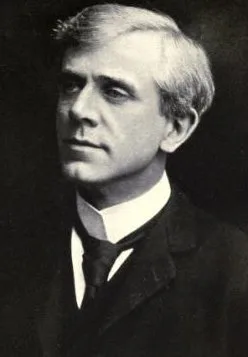
John A Pearson was born in Chesterfield, England in the year of Confederation – 1867. He apparently came from a family of builders and stonemasons apprenticing at a local firm in Chesterfield.
In 1888, when he was 21 years old, he emigrated first to New York then to Canada. He was a creative independent thinker who did not want to be stifled in the world of British architecture. He wanted the freedom to interpret and re-invent architectural styles instead of producing what he saw as ‘cookie-cutter’ versions of British architecture.
He worked with a couple of architectural companies such as Henry Sproat in 1890, then the firm of Darling, Curry, Sproatt, & Pearson in 1892. The other partners eventually moved on to other ventures so by 1895 he became a partner in the firm of Darling and Pearson (at age 28), seven years after arriving in Canada. He and Frank Darling both appreciated British and American architecture. They believed that they could combine both aspects of architecture to produce something uniquely Canadian.
They were brilliant architects in their own rights and shared similar architectural sensibilities. It is reported that Frank Darling was the quieter of the team while John A. was a very outgoing person. He was the networker who introduced clients to their work while Frank helped clients to flesh out the vision and design concepts they had for their building projects.
Apart from their shared architectural sensibilities, they shared a deep Christian faith. It is believed that Frank Darling was an Anglican Christian since his father was a rector of the Church of the Holy Trinity Anglican Church in Ontario. He also was the architect of choice for many of the Anglican churches in and around Toronto. John A. Pearson was a Presbyterian Christian who was committed to his faith and church community at St. Andrews Presbyterian Church in Toronto.
During WW1 he was a Sergeant with the 48th Highlanders Regiment all of whom came from St. Andrews Presbyterian Church. In fact, the St. Andrews Church was built in 1934 to memorialize the Officers and men of the 48th Highlanders who died in WW 1 & WW 2. The church has been designated an Historic Site.
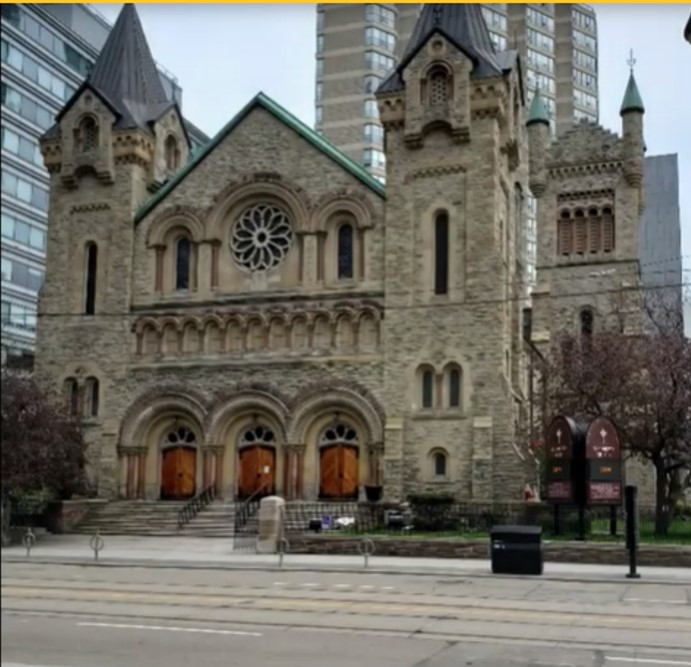
The main memorial in honour of the fallen soldiers is an exquisite oak Communion Table in the chancel beneath the Regimental Colours, built by John A Pearson. It was donated to the church by the Sergeants in memory of their fallen comrades of the First and Second World Wars. The table has been used, since its dedication, at every celebration of The Sacrament of Holy Communion.
The 5- paneled Communion table is built at two different heights. The central part is elevated above two abutments (extensions) on the ends. On the central part and around the lip of the table top, in one continuous line, is carved Jesus’ words: “Take, eat; this is My body which is broken for you.-This do in remembrance of Me. This Cup is the New Testament in My blood; this do ye. As oft as ye drink it in remembrance of Me”.
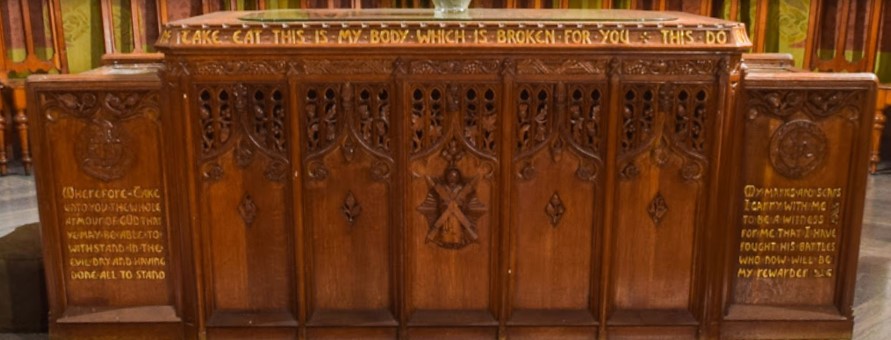
Symbols of Bread and Wine are carved in the upper part of each panel. On the centre panel of the front is a representation of the heraldic figure of St. Andrew while on the corresponding panel at the back is the Burning Bush with the legend “Nec Tamen Consumebatur” which means, And it was not consumed.
The extensions are narrower than the main table, are about six inches lower, have removable oak covers and are used as part of the table during Communion. They also serve as the repository of the ‘Book of Remembrance’ which bears the soldiers’ names in beautifully calligraphed letters. The oak tops cover a hinged frame of plate glass which houses the record of names of fallen soldiers. It can be opened and closed as needed and illuminated by a switch on the Chancel wall.
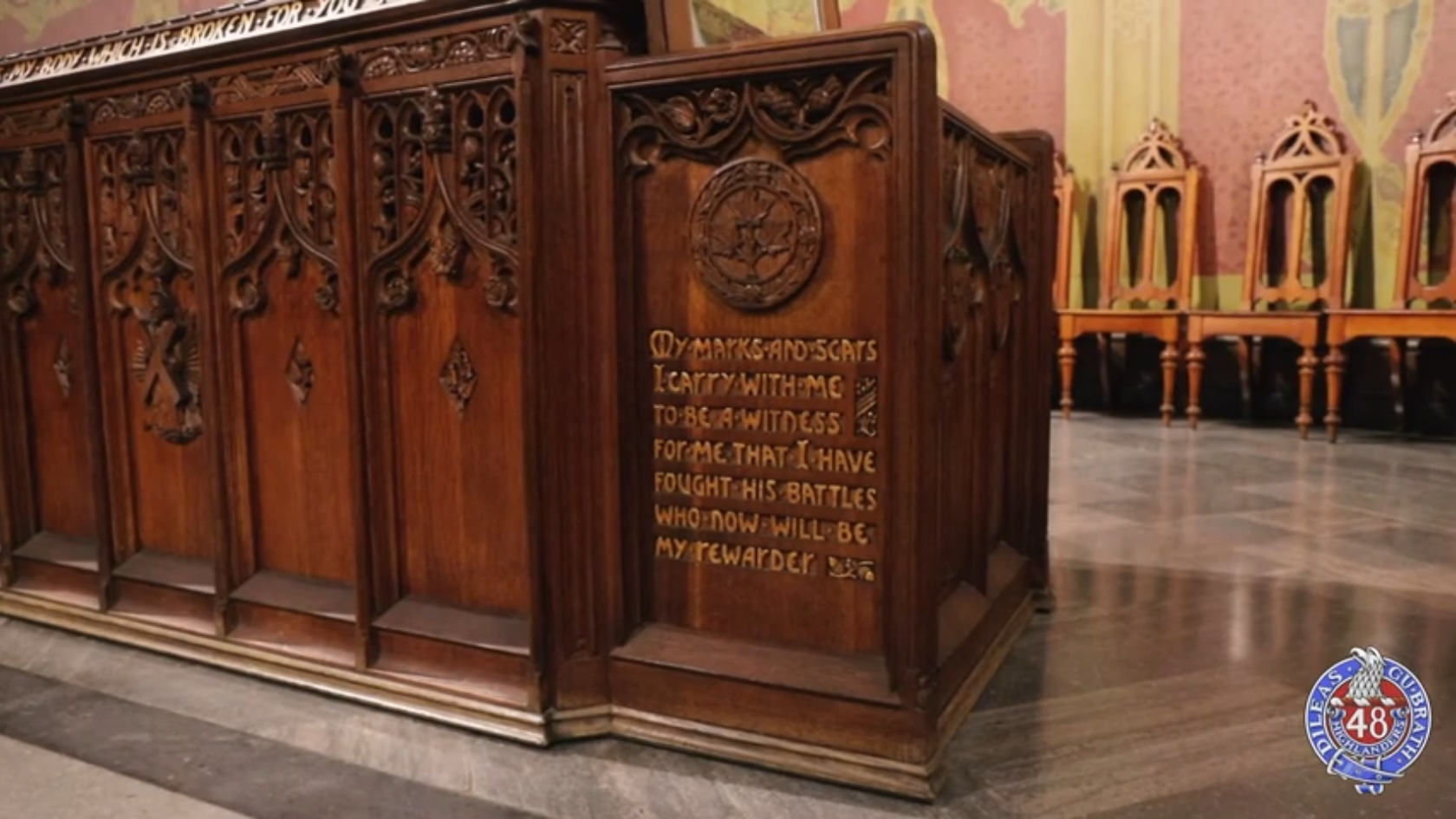
Under the oak top of this right extension is the hinged frame of plate glass which houses 25 loose leaf pages with the names and rank of the dead in both World Wars – 1818 soldiers. The beautiful calligraphy handwriting is large and legible. When the Book is opened, two pages with about 120 names are displayed. On the front of this extension is also carved the words from Bunyan’s Pilgrim’s Progress, “My marks and scars I carry with me to be a witness for me that I have fought His battles who now will be my rewarder.”
The symbols of the “Armour of God” are carved on the sides of both abutments – The Girdle of Truth The Breastplate’ of Righteousness, The Sandals of Peace, The Shield of Faith, The Helmet of Salvation and The Sword of The Spirit.
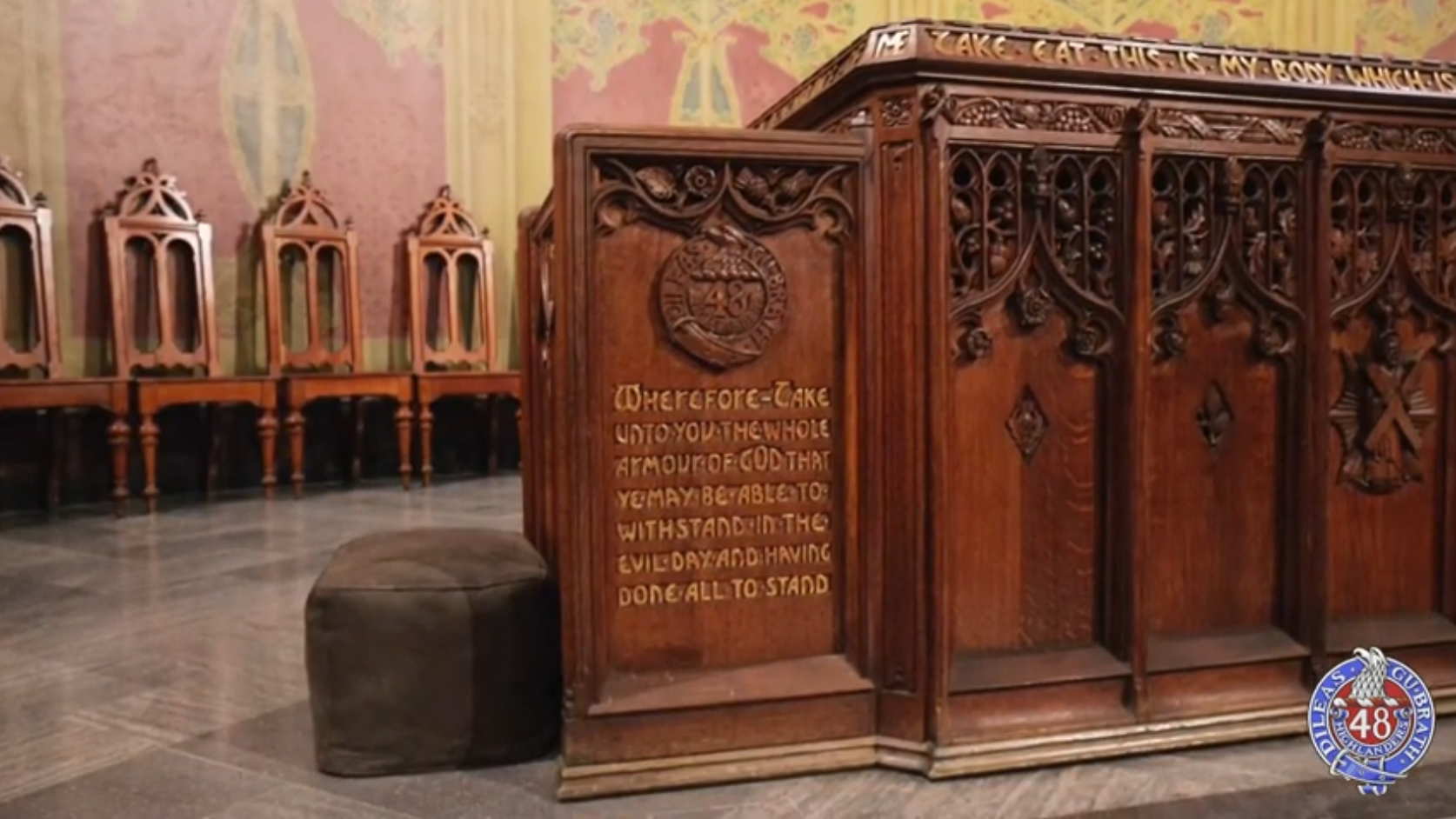
On the front of the left extension is the Regimental Crest and these words from Ephesians 6:11: “Wherefore take unto you the whole armour of God that ye may be able to withstand in the evil day and having done all to stand.”
Under the oak top of this left extension is the hinged frame of plate glass which houses the Title Page and dedication of all of the other pages ”engrossed on parchment within an artistic coloured border of flowers and symbols”. It reads:
“Their name liveth forevermore- Book of Remembrance 48th Highlanders – inscribed upon these pages are the names of those men of the 48th Highlanders of Canada who in the Great Wars gave their lives that those they left behind might be spared the ills which they themselves endured. Their comrades have placed this memorial beside The Lord’s Table in the trust that they, their wounds all healed, their sufferings overpast, may live forever in the light of His Kingdom Who gave His life a ransom for many.”
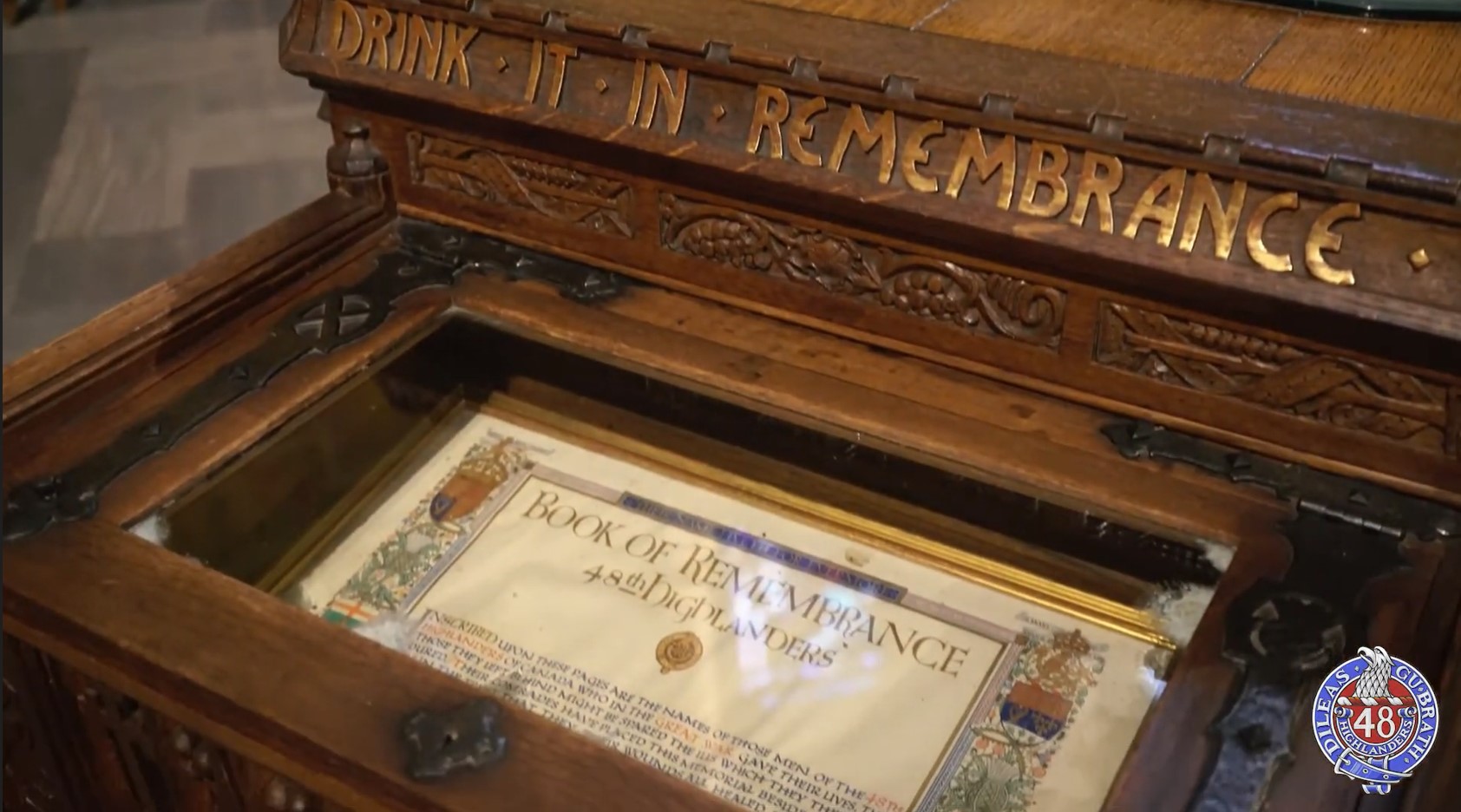
The Communion Table in St. Andrew’s Church, bears similar themes as the Altar of Remembrance in the Memorial Chamber of the Peace Tower. John A Pearson completed the Peace Tower in 1927 and St Andrews was built in 1934.
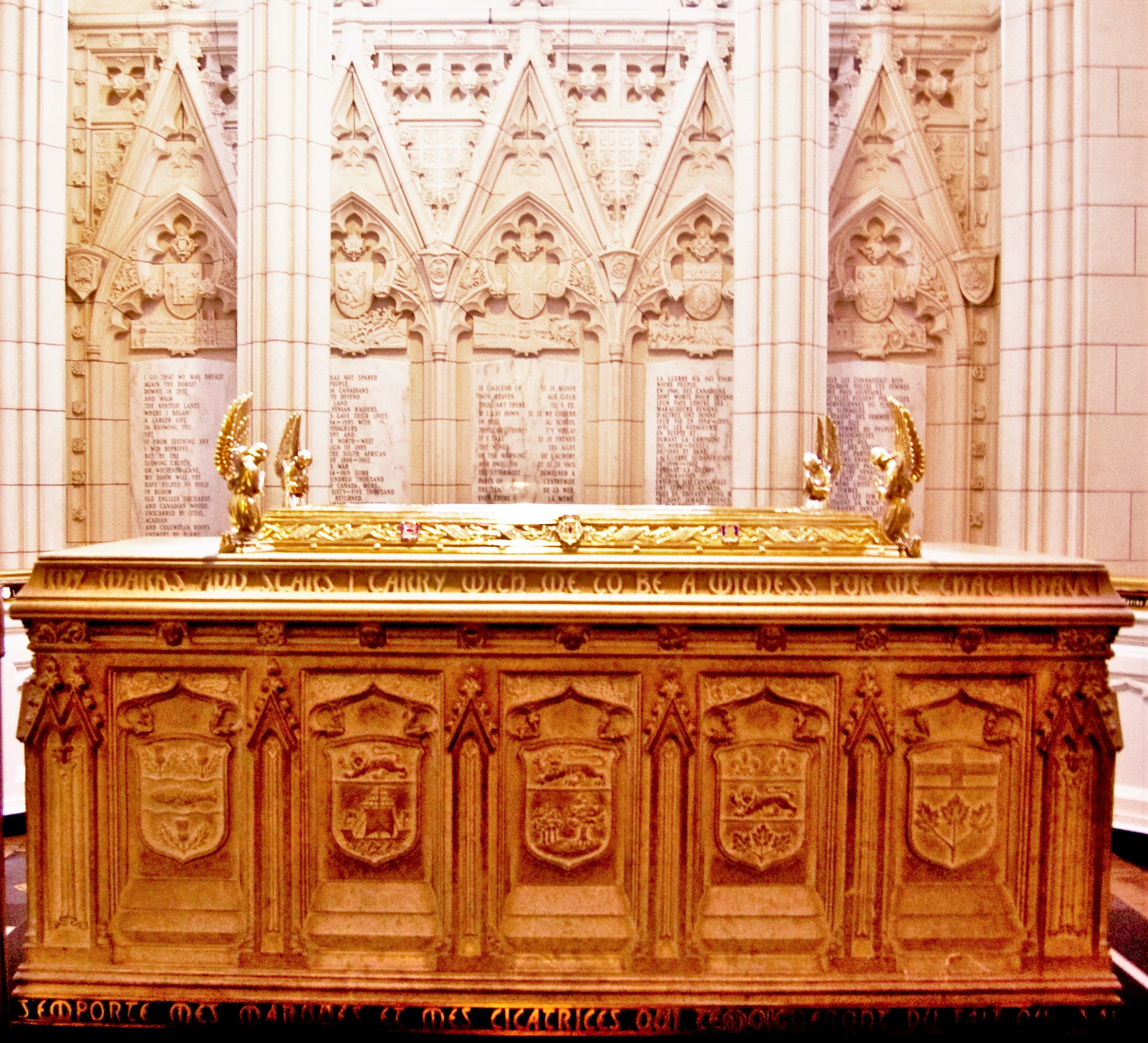
On the Altar of Remembrance, a hinged glass case houses the Book of Remembrance. On the bronze ribbon which surrounds the glass case is written Ephesians 6:11: “Wherefore take unto you the whole armour of God that ye may be able to withstand in the evil day and having done all to stand.” Six small blue shields are inserted in the ribbon pattern around the altar.
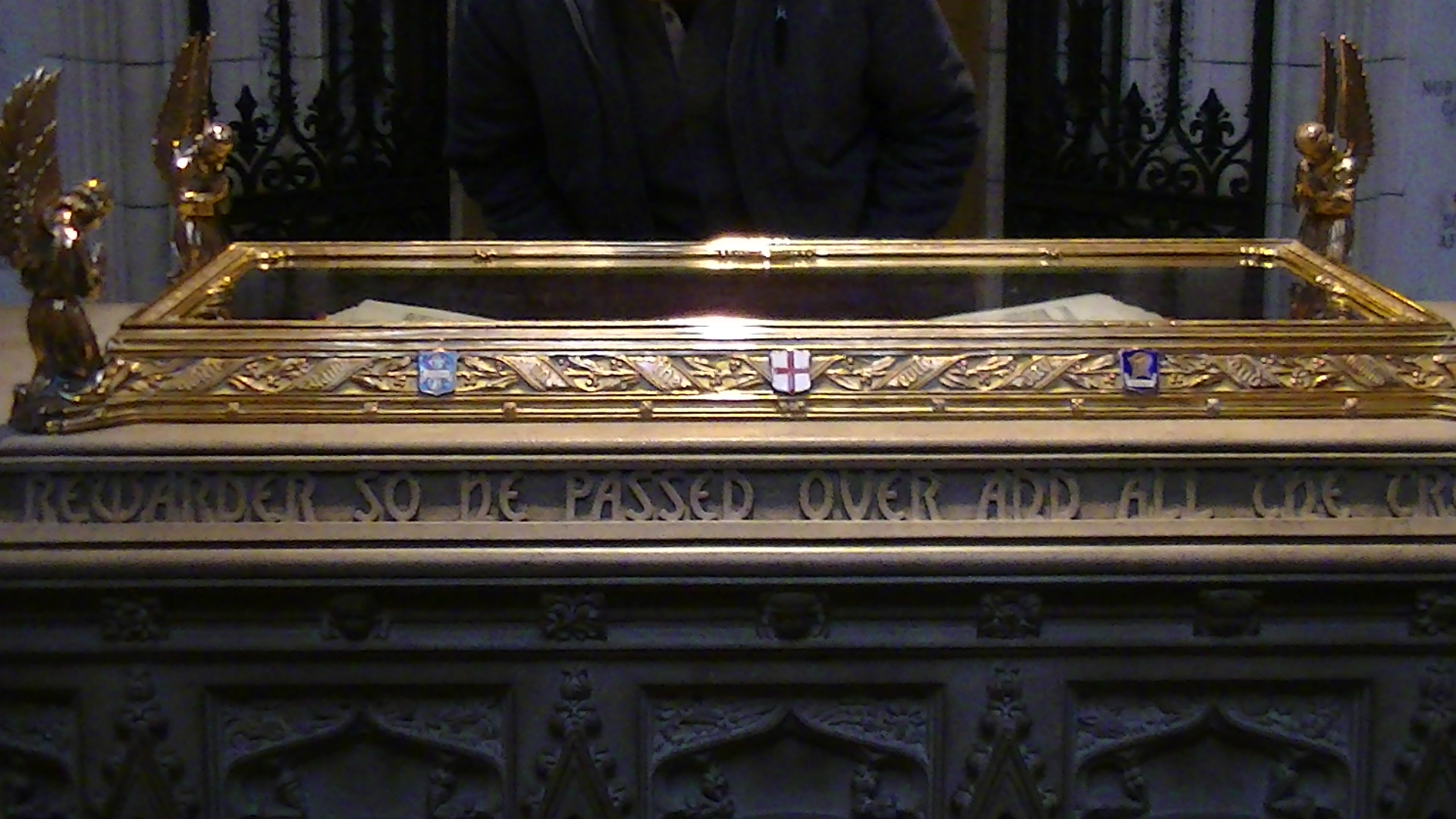
The Latin names for the six parts of the armour are written on those shields (Veritas for the Belt of Truth; Justitia for the Breastplate of Righteousness; Pax for the Sandal of Peace; Fides for The Shield of Faith; Salus for The Helmet of Salvation; and Spiritus for The Sword of The Spirit).
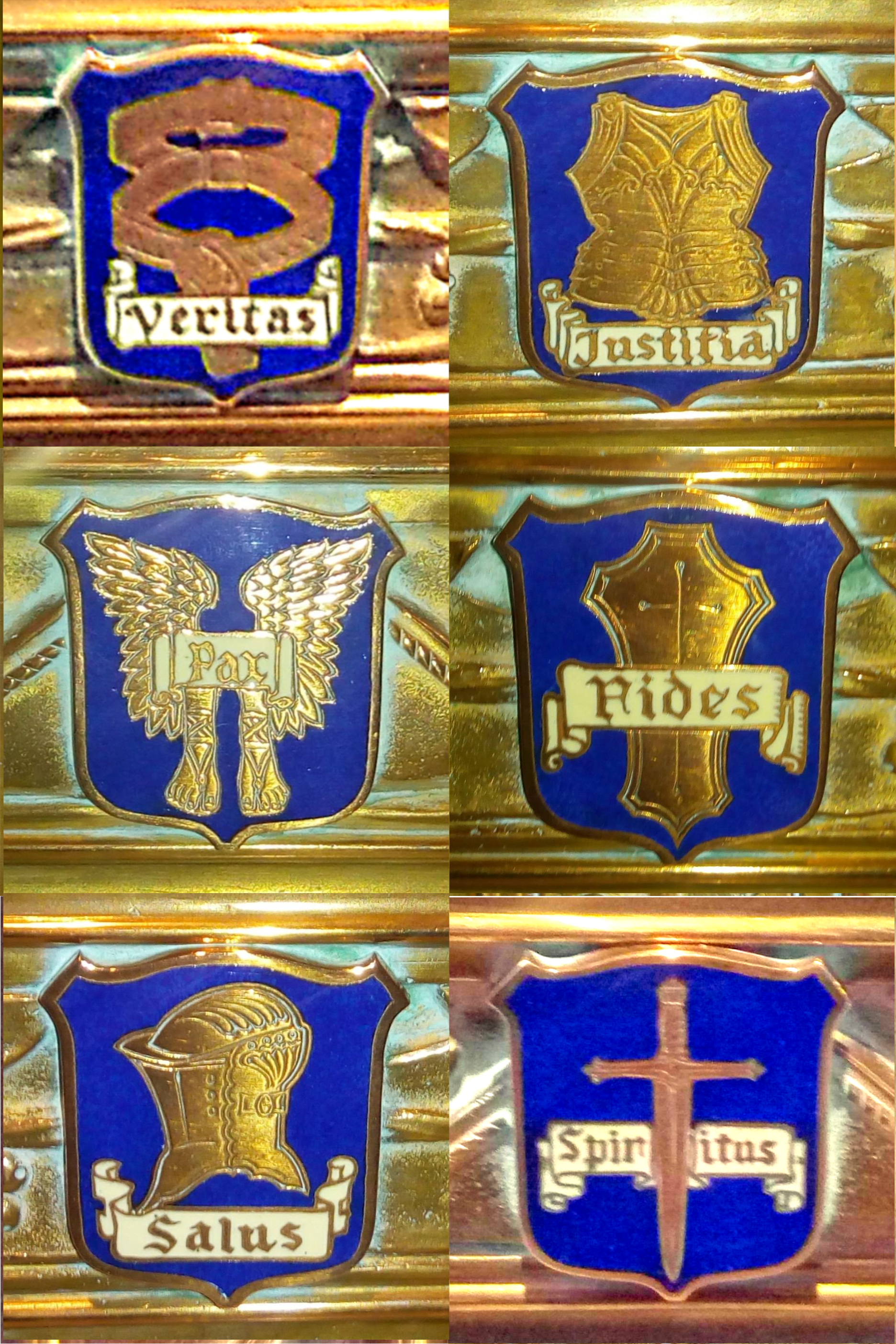
John A. Pearson did not become an expert Master Builder overnight. His career as an architect spanned 45 years, most of it during his partnership with Frank Darling. The duo became renowned for building large institutional structures (e.g., banks in Toronto, Montreal, Manitoba, Saskatchewan and British Columbia), hospitals and universities. Some of the impressive buildings they built between 1901 and 1914 include:
1901 – University of Toronto Faculty of Law, Flavelle House; 1904 – Union Bank building; 1905 – Former Bank Building on 197 Yonge Street; 1906 – Canadian Bank of Commerce Winnipeg; 1906 – Convocation Hall of U of T; 1908 – Moose Jaw Court House Sask.; 1906-1908 – The Grain Exchange Building Winnipeg; 1911 – Toronto General Hospital; 1911 – The Canadian Imperial Bank of Commerce in Winnipeg; 1913 – Canadian Pacific Building; 1914 – One King Street (now a high end hotel and condo building).
The buildings listed above display many aspects of Beaux-Arts architecture and exuded the idea of stability and endurance. This style of architecture incorporated the architectural grandeur of Greece and Rome which boasted imposing columns, high vaulted ceilings, marble and granite entrances, large ornate front doors of wood, bronze or a combination of both, and lots of arches, and decorative sculpture.
In 1916, Pearson was 49 years old when the Centre Block was destroyed by fire. Together with Omer Marchand from Montreal, Pearson won the contract to rebuild the Centre Block and Peace Tower of the Parliament Buildings.

His many decades of experience prepared him for the job of rebuilding the Centre Block. Pearson had built quite a number of huge and imposing structures from one end of the country to the other. By 1913 when he was 46 years old, the Year Book of Canadian Architecture had already designated him as a “Master Builder.”
His design utilized the footprint of Centre block that was already there from the old wooden building, but he improved on it to make it fireproof, more modern but yet blending in with the neo-gothic design of East and West Block of Parliament Hill.
It is said that Pearson had an eye for detail. He personally supervised every aspect of the building including both interior and exterior design such as the decorative elements of the stonework and metalwork. He designed over 40 unique rooms in the Centre block including the custom furniture in every room, determining the type of wood that was to be used for paneling and flooring.
This was his opportunity to display his genius and vision for the future. He incorporated both ceremonial and symbolic elements in his design with both parliamentarians and Canadian citizens in mind. This is especially true with the culmination of the Peace Tower and Memorial Chamber.
In an interview with Macleans Magazine, Johanna Mizgala, Curator of the House of Commons, points out the intentionality of the many unique design elements of the Centre Block. For example, the base of the central column of the rotunda was designed with an image of Poseidon, the Greek God of the Sea.
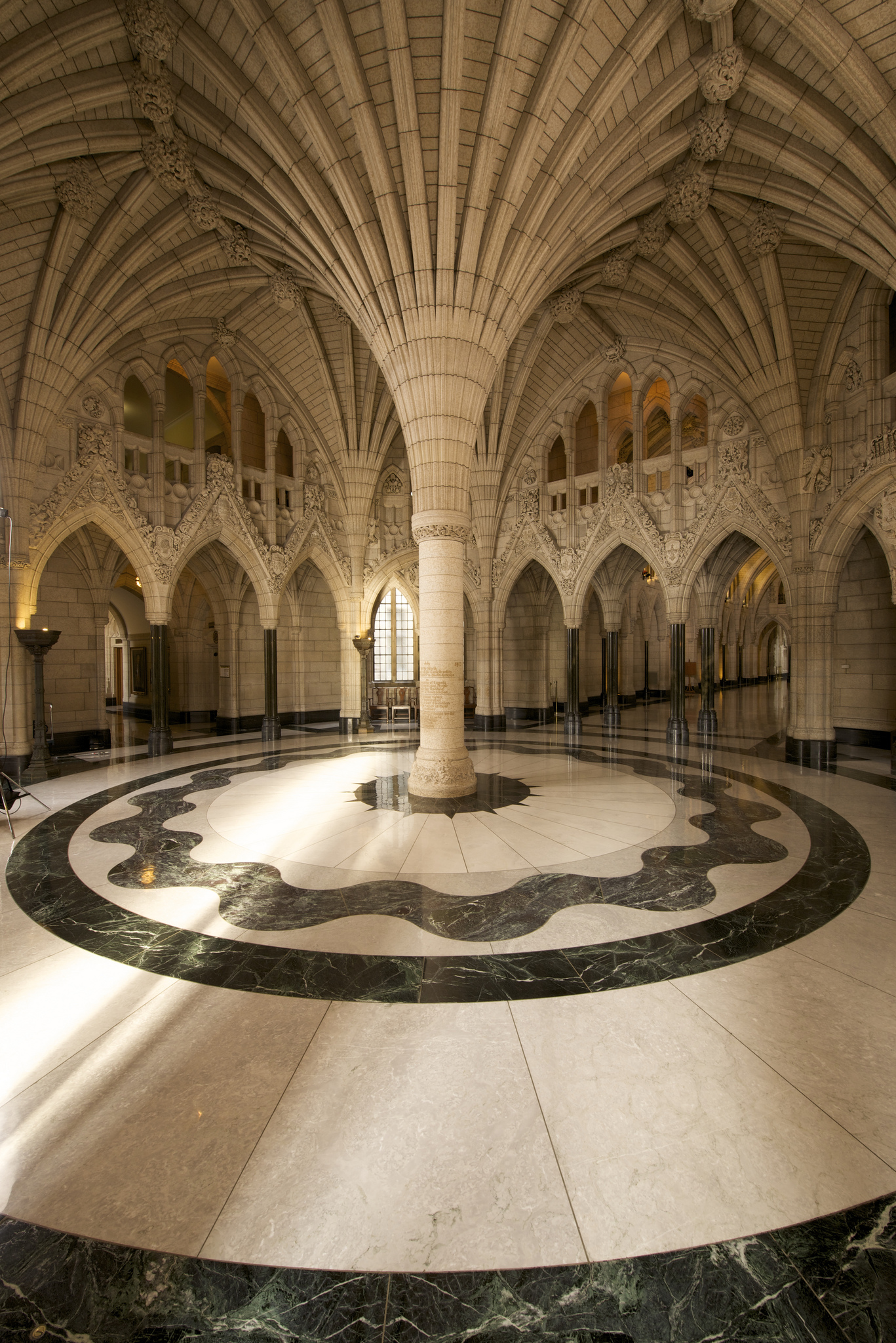
The coloured marble on the floor was designed to represent a compass surrounded by the sea. The intent was to represent the building as the ‘ship of state’ which would inspire calm when the ‘seas are rough’, with the Prime Minister as the captain of the ship. Continuing the theme of the ‘ship of state’, the Prime Minister’s office is recognized by a carving of a phoenix over the door – the symbol of rising from the ashes.
There are also portraits of explorers and navigators, like John Cabot and Christopher Columbus, carved into the plaster of the ceiling. The idea was to surround and inspire the Prime Minister with navigators and captains who were trustworthy and of good repute.
Pearson designed the Peace Tower to express gratitude for peace after the horrors of WW1. For him, the Memorial Chamber was a kind of a ‘shrine of remembrance’ to those who gave their lives in the war. His attention to detail and involvement in every aspect of the vision for the building, is demonstrated by the fact that very early in his construction, he asked our allies, Britain, France and Belgium, to provide stone for his use in the Memorial Chamber. He initiated visiting them to have that conversation, sharing his drawings with them and requesting the stone he needed. He was amply supplied.
He visited the battlefields where our soldiers died, to collect stones from each site for use in the Memorial Chamber. He also collected spent shells from the various battlefields which he had melted to engrave the names of said battlefields in the floor of the Memorial Chamber.
The nature and context of the Scripture verses he chose for inclusion in the Peace Tower of the Parliament Buildings, tell of his deep and intimate knowledge of the Scriptures. The exquisite Communion Table at the St. Andrews Presbyterian Church and the words engraved on it all point to a man who believed in the sacrificial death of Christ and the resurrection of believers to eternal life. This was a man of deep and abiding Chritian faith.
Pearson wrote to Prime Minister MacKenzie King in 1927 explaining his thoughts about what he wanted the Peace Tower to represent. In it, he said, in part,
“In all my thoughts of the tower, peace was dominant. I believe there is a quiet peaceful dignity about it. I somehow bring myself to read it that way—no matter what troubles and worries and differences of opinion take place in the building. I feel that one cannot approach the building up the centre road without experiencing its mute appeal for toleration, moderation, dignity and peace.”
Ms. Mizgala says of Pearson, ‘he had the soul of a poet’. Pearson ended his letter to King with an apology for his ‘unpolished prose’, ending with, ‘I would rather write in stone than on paper’.
By the time he had completed rebuilding the Centre Block in 1920, he was 53 years old. He completed the Peace Tower in 1927 when he was 60 years old. In 1932, his genius and prominence in the architectural community was recognized by the University of Toronto. He was the first architect to receive an honorary Doctor of Architecture Degree. In 1934, St Andrews Presbyterian Church was built, and four years later, in 1940, John Andrew Pearson passed into the arms of his Saviour.
Author’s Note: Lynette is the owner of ChristianRoots Canada. Blogger. Publisher. Course Creator. Passionate about Canadian History from the perspective of God’s Providence.
The Dark Ages & the French Wars of Religion Some time ago, I started to
In many places, like legislatures and schools, the Bible is considered ‘hate literature’. Counseling someone
Britain’s claim of Rupert’s Land by the Doctrine of Discovery, proved to be one of
Dominion Day had been a federal holiday that celebrated the enactment of The British North American Act which united four of Britain’s colonies – Nova Scotia, New Brunswick, Upper and Lower Canada (which became Ontario and Quebec), into a single country within the British Empire, and named that country The Dominion of Canada.